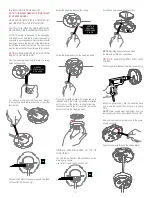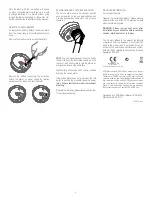
Connect the 4 wires to the power supply: Live feed
(L1), neutral (N), Ground ( ), lamp feed wire (L2).
Install the wires as shown.
Install the cableholder and replace the cover.
NOTE: After putting the wires through the alarm,
check if the test button can move free. If the hole
is too small the test button cannot move.
can be added to the system
Minimum 10cm
6.
TEST FUNCTION:
After installation, and at least once per quarter,
test all of your alarms to ensure they are operating
correctly and are within range of each other.
It is recommended to check visually every week if
the LED flashes correctly (every 48sec.).
Press the test button on any alarm for at least 10
seconds.This will send out a test signal from the
alarm; all other connected alarms should receive
the signal within a short time. The alarms will emit
a short beep and the LED will flash every 8 sec-
onds for 2 minutes.
NOTE: Test function also transmits a weaker RF
signal to ensure an optimal operation in normal
conditions.
When the test signal is sent out, the alarms will
respond in two ways:
1. A single beep every 8 seconds indicates that
the alarms are connected and functioning.
2. Three short beeps every 8 seconds indicates a
smoke sensor fault. The alarm should be cleaned
by running the vacuum (on a low setting) around
the smoke alarm chamber and tested again.
If required this indication can be stopped early on
each alarm by a short press of the test button.
TIP: It is safe to cover the sound output holes with
your finger or a cloth during the testing to minimize
the sound level emitted.
If the problem continues, please visit www.cavius.com
for any trouble shooting.
7.
NORMAL MODE:
In normal mode the LED will flash every 48 seconds
to show correct operation.
The green LED is on when the alarm is connected
to mains power. It may take up to 1 minute to
indicate that mains power has been connected.
8.
ALARM MODE:
When the smoke is detected, the smoke alarm will
go into ‘Alarm Mode’. It will sound the alarm signal
and the red LED will flash.
The smoke alarm will also transmit the alarm signal
to the other connected alarms, which will also
sound the alarm signal after a short delay.
The CAVIUS Wireless Family have two different
alarm signals:
Alarm signal 1 (--- --- ---) is life threatening
alarms, like a smoke alarm.
Alarm signal 2 (- - -) is a non life threatening
alarm, like a flooding alarm:
Smoke alarm signal: --- --- ---
Heat alarm signal: --- --- ---
Flood alarm signal: - - -
CO alarm low level signal: - - -
CO alarm high level signal: --- --- ---
Please note that only the originating alarm’s red
LED will flash, so it can be identified.
9.
PAUSE/HUSH FUNCTION:
If the smoke alarms are to set into a false alarm by
cooking, fireplace, etc. they can be paused for 10
minutes by pressing the test button on the origi-
nating smoke alarm only (indicated by the flashing
LED).
The reason for this is that it is necessary to locate
the source of the alarm before using the hush
function. This is to make sure that it is not a life
threatening situation.
10.
ADD EXTRA DEVICE:
The mains powered smoke alarm can be used
together with the alarms in the CAVIUS wireless
family: Smoke, Heat, Flood, CO & mains power
alarms. All CAVIUS interconnected alarms within the
as they run on the same frequency and use the
same data protocol.This means that the wireless
system can consist of a combination of smoke,
heat, flood etc.
Place all alarms into ‘Learn Mode’ and repeat
section 1.
Always test connection to all devices by repeating
test function section 6 after adding devices.
11.
LOW BATTERY SIGNAL:
Your product has a battery back-up with a 1 year
life in battery mode without mains power, and up
to 10 years normal life with mains. However, we
recommend to replace the battery every 5 years.
When the battery is starting its end of life, a short
beep will sound out every 48 seconds for 30 days.
Light bulb: maximum 75W
Lamp: maximum 2 kgs weight
3
L2
N
L2
N
L1
N
N
L1 L2
HEAT ALARM
SMART REMOTE
FLOOD ALARM
SMOKE ALARM
MAINS POWERED
SMOKE ALARM






















